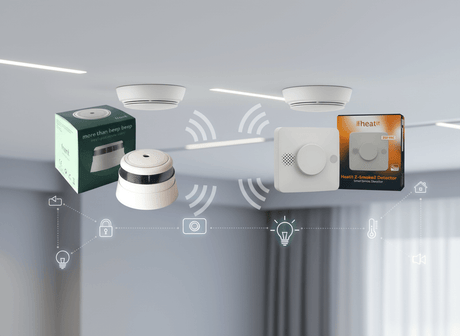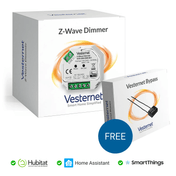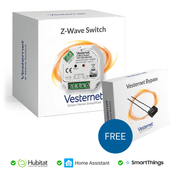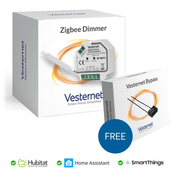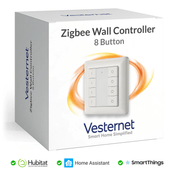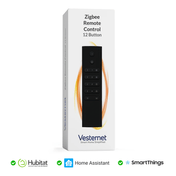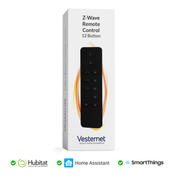Modern homes demand smarter fire protection as traditional smoke detectors fall short when homeowners are away. The rise of smart home security adoption has highlighted a critical gap: conventional alarms can't alert you to emergencies when you're not physically present to hear them.
This comparison examines two leading smart detectors - the battery-powered Frient Zigbee solution versus the hardwired Heatit Z-Wave system - helping you choose between convenient installation and professional-grade reliability. We'll explore installation requirements, detection capabilities, and integration features to guide your decision.
At Vesternet, our expertise in smart home safety technology ensures you receive honest guidance about fire protection systems, empowering you to make informed choices that genuinely protect your property and loved ones.

Battery-Powered Simplicity: Understanding the Frient Zigbee Solution
The Frient Intelligent Smoke Sensor represents the pinnacle of user-friendly fire protection, delivering professional-grade safety through an elegantly simple battery-powered design. This compact Zigbee device transforms traditional smoke detection by adding remote notifications and smart home connectivity without requiring any electrical expertise.
Core Detection and Connectivity Features
- Wireless Zigbee technology for seamless smart home integration
- Remote notification system alerting you anywhere via smartphone
- Interconnected alarm network linking multiple sensors throughout your home
- Battery-powered operation eliminating installation complexity
The system excels at providing immediate fire awareness whether you're sleeping upstairs or travelling abroad. Its intelligent networking ensures that when one sensor detects smoke, all connected units activate simultaneously, creating a comprehensive alert system that adapts to your home's layout and your lifestyle demands.

Hardwired Intelligence: Exploring the Heatit Z-Wave Multi-Sensor Approach
The Heatit Z-Smoke 2 elevates fire detection through sophisticated multi-criteria sensing technology, combining optical smoke detection with advanced heat monitoring and temperature reporting. This Z-Wave enabled device operates on mains power, ensuring consistent performance without battery maintenance concerns.
Advanced Detection Capabilities
- Multi-criteria sensor technology distinguishing between fire types
- Intelligent filtering preventing false alarms from cooking smoke
- Heat sensing and continuous temperature monitoring
- Z-Wave S2 security protocol for robust smart home integration
The device's ability to differentiate between fast-burning flames and slow-smoldering fires represents a significant advancement in home fire protection. Its 230 VAC power supply guarantees reliable operation, while the sophisticated sensor array provides comprehensive environmental monitoring beyond basic smoke detection.
Power Sources and Installation: DIY Battery vs Professional Hardwiring
Installation requirements represent the most significant difference between these smart detectors, fundamentally affecting who can implement them and how they integrate into your home's infrastructure. The battery-powered approach prioritises accessibility and immediate deployment.
Battery-Powered Installation Benefits
- Ceiling mounting with simple screws - no electrical work required
- Instant setup compatible with rental properties
- Flexible positioning anywhere within Zigbee network range
- Minimal tools needed for complete installation
However, battery systems require ongoing maintenance through periodic replacement, typically every 2-3 years depending on usage patterns. This creates recurring responsibility but eliminates complex installation barriers that prevent many homeowners from upgrading their fire protection.
Hardwired System Considerations
- 230V mains connection requiring qualified electrician installation
- Permanent power supply eliminating battery replacement needs
- Professional-grade mounting ensuring optimal sensor positioning
- Integration with existing electrical infrastructure
Mains-powered systems demand higher upfront investment in professional installation but provide long-term reliability without ongoing maintenance concerns. The permanent power connection ensures consistent operation and eliminates the risk of battery failure compromising your home's fire protection during critical moments.
Detection Accuracy: Basic Smoke Sensing vs Multi-Criteria Fire Analysis
Performance differences between single-sensor and multi-criteria detection become apparent in real-world scenarios, particularly in kitchens and areas prone to environmental variations. The Frient provides reliable photoelectric smoke detection optimised for residential fire scenarios.

Standard Smoke Detection Performance
- Photoelectric sensing effective against smoldering fires
- Rapid response to visible smoke particles
- Consistent performance across typical residential fire types
- Network connectivity enhancing overall home coverage
Multi-criteria systems like the Heatit analyse multiple environmental factors simultaneously, creating a more nuanced understanding of potential fire conditions. This sophisticated approach significantly reduces false alarms while improving detection speed for various fire types.
Advanced Multi-Sensor Advantages
- Heat and smoke correlation preventing cooking-related false alarms
- Temperature monitoring providing early fire stage detection
- Intelligent algorithms distinguishing harmless steam from dangerous smoke
- Enhanced accuracy in challenging environments like kitchens
The temperature sensing capability adds valuable environmental monitoring, helping identify developing fire conditions before visible smoke appears and providing continuous home climate awareness beyond fire protection duties.
Frient Zigbee Smoke Sensor: Simplicity Benefits and Battery Limitations
The Frient system excels where convenience and accessibility matter most, offering professional-grade fire protection without professional installation requirements. Its Zigbee connectivity integrates seamlessly with popular smart home platforms including Homey, SmartThings, and Smart Home by Hornbach.
Key Advantages of Battery-Powered Design
- Immediate installation without electrical expertise or permits
- Perfect for rental properties and temporary installations
- Interconnected network amplifying detection across your home
- Remote notifications enabling response when away from property
However, battery dependency creates ongoing responsibilities and potential vulnerabilities. Regular battery monitoring becomes essential, and power depletion could compromise protection during extended absences. The system also requires a compatible Zigbee hub for smart features, adding infrastructure complexity and potential single points of failure to consider in your overall home automation strategy.
Heatit Z-Wave Detector: Advanced Features vs Installation Complexity
The Heatit Z-Smoke 2 provides professional-grade fire detection through its multi-criteria sensing approach, delivering sophisticated analysis that significantly reduces false alarms while improving genuine fire detection accuracy. Its mains power connection ensures consistent operation without maintenance interruptions.
Professional-Grade Detection Benefits
- Multi-criteria analysis preventing false alarms from cooking activities
- Permanent mains power eliminating battery replacement concerns
- Heat sensing providing early fire stage detection capabilities
- Temperature monitoring offering additional home environmental data
Installation complexity represents the primary barrier, requiring qualified electrical work and potentially building regulation compliance depending on your local requirements. The higher upfront investment includes both device and installation costs, though long-term reliability and advanced features often justify this initial expense for homeowners prioritising comprehensive fire protection systems.
Matching Fire Protection to Your Living Situation
Choosing between these smart detectors depends heavily on your living situation, technical capabilities, and long-term fire protection priorities. Rental properties and DIY enthusiasts naturally gravitate towards battery-powered solutions for their installation simplicity and portability.
Ideal Scenarios for Battery-Powered Systems
- Rental properties where permanent modifications aren't permitted
- Quick smart home upgrades without electrical work
- Temporary or seasonal property protection
- Homes lacking existing hardwired smoke detector infrastructure
Homeowners planning long-term improvements often prefer hardwired systems for their professional-grade performance and maintenance-free operation. Properties with existing electrical infrastructure or those undergoing renovation provide ideal opportunities for professional detector installation.
Hardwired System Advantages for Permanent Installations
- New construction or major renovation projects
- Homeowners prioritising maximum detection accuracy
- Properties requiring comprehensive fire protection compliance
- Situations where ongoing maintenance scheduling proves challenging
Consider your technical comfort level, property ownership status, and maintenance preferences when evaluating these options. The best fire protection system balances detection effectiveness with practical implementation constraints, ensuring consistent operation that matches your lifestyle and property requirements.
Choosing Your Smart Fire Safety Guardian
Both smart detectors offer substantial improvements over traditional smoke alarms through remote notification capabilities and smart home integration, but they serve distinctly different installation preferences and performance expectations. The choice ultimately depends on balancing convenience against advanced detection features.

Key Decision Factors
- Installation capability: DIY battery versus professional hardwiring requirements
- Detection needs: basic smoke sensing versus multi-criteria fire analysis
- Maintenance preferences: periodic battery replacement versus permanent power
- Property type: rental flexibility versus permanent homeowner installation
Neither option represents a compromise in basic fire protection effectiveness - both systems provide reliable smoke detection with smart home benefits. Your specific circumstances, from technical expertise to property ownership status, should guide your decision rather than assuming one approach universally outperforms the other across all situations.
Making the Right Choice for Your Fire Safety Needs
Both the Zigbee Frient Intelligent Smoke Sensor and Z-Wave Heatit Z-Smoke 2 offer excellent smart fire protection, but serve different needs and installation preferences. The Frient excels in simplicity and quick deployment, making it perfect for renters or those wanting immediate smart home integration without electrical work.
The Heatit provides superior detection accuracy and permanent reliability, ideal for homeowners seeking professional-grade fire protection with advanced multi-criteria sensing. Consider your installation capabilities, detection requirements, and long-term maintenance preferences when making your choice.
Both systems significantly enhance your home's fire safety through remote notifications and smart connectivity. Explore the Frient Intelligent Smoke Sensor for convenient battery-powered protection, or discover the Heatit Z-Smoke 2 for comprehensive hardwired detection. Check out both products on Vesternet to find the smart smoke detector that best protects your home and fits your lifestyle.


